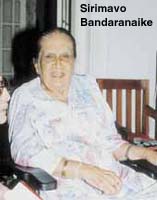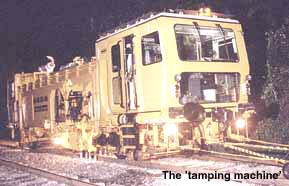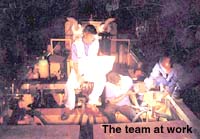
16th April 2000
News/Comment|
Editorial/Opinion| Business| Sports|
Sports Plus| Mirror Magazine

Prime Minister Sirimavo Bandaranaike celebrates her 84th birthday tomorrow
"The only man in her Cabinet"
By Roshan Peiris
 Sri
Lanka's Queen Mother, Sirimavo Bandaranaike celebrates her 84th birthday
tomorrow, April 17.
Sri
Lanka's Queen Mother, Sirimavo Bandaranaike celebrates her 84th birthday
tomorrow, April 17.
Mrs. Bandaranaike, three times Prime Minister, took to politics at 44 when husband S.W.R.D. was assassinated.
Respected as the elder stateswoman of Sri Lanka, she has made it clear that her political clout has withstood the vagaries of time and disabling illness, which confines her to a wheelchair.
Her mind remains amazingly alert and she once told me: "I have no cholesterol, heart disease or diabetes. I am ill because of my injured feet. If Franklyn Roosevelt ruled the US while confined to a wheelchair, so can I."
Mrs. Bandaranaike's political record remains unmatched for she was the first woman Prime Minister in the world.
As a young girl on the Ratwatte estate in Balangoda, she never dreamt that greatness would virtually be thrust upon her. A family friend, Mrs. Clarice Gomes had read her palm and predicted to a bewildered Sirimavo that she would become eminent in politics. Even today she recalls this prediction.
After she married the Oxford-educated, silver-tongued orator, S.W.R.D. Bandaranaike who was a minister, she remained in the background looking after him and her three children. But the assassin's bullet changed her life.
Her husband's party, the SLFP looked to her for leadership and she recalls, "I had to take it to implement the policies and visions of my beloved husband."
In 1962, she successfully foiled a coup and in 1971 she was able to overcome an insurrection by the Janatha Vimukthi Peramuna (JVP) which attempted to overthrow her government.
This was the first taste of terrorism in Sri Lanka and that irrepressible statesman Sir John Kotelawala said at the time that she was the only man in her Cabinet!
She kept her cool and called upon the misguided youth to give up arms and promised to forgive them.
In 1977 her party was defeated and in 1980 she was stripped of her civic rights by the government of President J.R. Jayewardene. She was angry but not for long. She overcame her 'disability' by buckling down to inspire and rejuvenate her party and ultimately handed over the reins to daughter Chandrika.
Today, Mrs. Bandaranaike can look back with a sense of achievement. She made a major impact in world politics during her tenure from 1970–77 when she hosted the fifth Non-Aligned Summit on August 4, 1976.
However, the nationalisation of Lake House and the sealing of the 'Sun' Group of newspapers marred her rule during this period.
Still she is the Grande Dame of Sri Lanka.
Oddly Occupied
A tamping we will go
By Udena R. Attygalle
 We
bumped along, swinging to the metallic blaring of a radio that screamed
above the roaring engine. The siren light gave an orange glow to everything.
We
bumped along, swinging to the metallic blaring of a radio that screamed
above the roaring engine. The siren light gave an orange glow to everything.
We were in the front cabin of the Railway Department's 'tamping machine', an engine- like yellow monster that doctors the railtrack. IPW (Inspector, Permanent Way) Janath Wijesuriya in charge of the machine was in the driving seat with his partner IPW Nalinda Perera next to him. The time read 9.43 p.m. and it looked as if we were going to be awake the whole night!
We were going to "tamp" the track between Ambepussa and Alawwa, "lifting, levelling and aligning it. The track had lost its shape due to the constant battering from bogie wheels. Without regular tamping, passenger comfort is reduced drastically. This usually translates into that sickening sideways rocking movements that train-users are familiar with.
In the front cabin Janath explains, "This machine has the longest wheelbase of any engine in the country and the suspensions aren't great as well." Rocking and rolling every time we hit a joint, we had already figured that out! We were travelling uncomfortably so that others could travel in comfort: it was ironic.
The Austrian consultant who was in charge of personnel training had stressed that it should be driven by technicians and not engine drivers. "He was a bit mad when a couple of drivers were included in the training programme," Janath recalled. This machine meanwhile, does not have a "dead man's pedal" the safety mechanism that ensures that the engine stalls if something happens to the driver.
Janath and Nalinda are products of the Technical Training Institute in Katunayaka. While Janath was part of the original crew, Nalinda's attachment to the machine came after a time spent in Welikanda. They, together with technical fitters Uthpala Vithana and P. H. Sarathchandra (Sarath) and four others, form the team.
Talking about railways and engines we proceed. We swap old stories. "Once we spotted this tortoise trying to cross the track somewhere near Ganegoda,"Janath says with a wry smile. "We felt sorry for the poor fellow so we picked him up and gave him a lift to a safer place two stations farther up!"
And then there was the time when a man jumped onto the track. "I didn't see him on time. I pressed the brake but it was too late. I saw the machine going over him, it was quite bad," he said. (The cabin's front floor is transparent and you can almost see the wheels).
 We
come to a halt at the Ambepussa station. Arranging to work the traffic
of the double line between Alawwa and Ambepussa over a single line, we
have the 'up line' all to ourselves. Coming to a halt about two kilometres
away from the station, the team is ready to start work.
We
come to a halt at the Ambepussa station. Arranging to work the traffic
of the double line between Alawwa and Ambepussa over a single line, we
have the 'up line' all to ourselves. Coming to a halt about two kilometres
away from the station, the team is ready to start work.
"Be careful when you are on the down track; you can't hear the train coming because we will be making a big racket," says Janath. He then sends two watchers about 400 metres on either side of the track. They in turn place small explosives that do no harm but make a lot of noise to warn stray trains of the presence of danger ahead.
The watcher also radios in when there is traffic on the other track and the tamping machine's siren is blown to warn the workers. "One of the workers got it just last Saturday," Janath makes a point.
Pouring me a steaming cup of plain tea, worker Gunarathne mumbles, "We live on tea". "And cigarettes," chips in Nalinda taking one out of his pocket. "We would just fall asleep without them." One o'clock in the morning and my head is heavy. I thankfully grab the hot cuppa.
Janath explains the work. The bottom of the machine is flooded with light, though the searchlight can only pierce the darkness around us for less than 100 metres. Sets of crow bar like units are lifting the track, another set, pushing the metal under the track. All synchronized by Uthpala who is in the rear cabin. A 'rear tightening trolley' is attached to the machine. "This increases the accuracy of the measurements," says Janath.
The angle of lift and alignment are all handled by Nalinda who sits in the front cabin. He enters the data and the onboard computer takes care of the rest.
We slowly walk into the darkness in front of the machine, Janath's torch searching the sleepers. We spot numbers on them — 18 on one, 20 on the other and so on. That indicates the centimetres that the sleeper should be lifted. We sit and take the longitudinal measurement of the sleeper. It shows that it is way off its due angle.
We mark the sleeper and decide to see the difference after the machine has been over it. We squat on the track and Janath fills me in on all the background details. "This machine on average 'tamps' a distance of about 1,300 sleepers. All this is within the four hours when the track is given to us," Janath explains. It usually takes the whole day for this task to be done manually. "And then the tracks go off their original radius because of the manual method."
The tamping team utilizes the "compensation method". The other one, the "precision method" while being more accurate would require the re-plotting of the whole track. "The track as it is now is totally off its original radius: it does not conform to the maps," Janath points out. "So we just try and tamp the tracks as much as we can: length-wise."
"We had to do a lot of experimental work before we got to this stage," he says. "These days the machine is like our own; when we are not using it we are usually spending time maintaining it."
Usually gangs of up to 30 men would travel the track smoothing it out. Lying down they would check the smoothness of the track with the naked eye. Then up to 15 men, crowbars in hand would lift the track to the cry of "hoy hop hop". After awhile the machine is over the spot we had marked. And we take the measurements again. The chalk mark on the sleeper reads 18 and our reading is 18.5. Not bad! Just a difference of 0.5 m.m.
A hydraulic hose suddenly breaks and oil spurts out. The engine goes off immediately: a built in safety mechanism. Sarath and Navarathne try to get things in order but the hose has to be replaced. It's 3 a.m. and work has to be cut short.
We get on the machine and move into the Ambepussa station where it is to be parked for the night. "We don't use the machine to get back to Colombo in order to reduce the wear and tear," Nalin had explained earlier.
A dab of water on our faces and we are rushing to catch the 4.30 to Colombo. That was our day with the tamping crew and boy were we tamped!








![]()
Front Page| News/Comment| Editorial/Opinion| Plus| Business| Sports| Sports Plus| Mirror Magazine
Please send your comments and suggestions on this web site to

